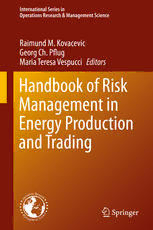
Handbook of Risk Management in Energy Production and Trading PDF
Preview Handbook of Risk Management in Energy Production and Trading
International Series in Operations Research & Management Science Raimund M. Kovacevic Georg Ch. Pfl ug Maria Teresa Vespucci Editors Handbook of Risk Management in Energy Production and Trading International Series in Operations Research & Management Science Volume 199 SeriesEditor FrederickS.Hillier StanfordUniversity,CA,USA SpecialEditorialConsultant CamilleC.Price StephenF.AustinStateUniversity,TX,USA Forfurthervolumes: http://www.springer.com/series/6161 Raimund M. Kovacevic • Georg Ch. Pflug Maria Teresa Vespucci Editors Handbook of Risk Management in Energy Production and Trading 123 Editors RaimundM.Kovacevic GeorgCh.Pflug DepartmentofStatistics&OR DepartmentofStatistics&OR UniversityofVienna UniversityofVienna Wien,Austria Wien,Austria MariaTeresaVespucci DepartmentofIT&MathematicalMethods UniversityofBergamo Dalmine,Bergamo,Italy ISSN0884-8289 ISBN978-1-4614-9034-0 ISBN978-1-4614-9035-7(eBook) DOI10.1007/978-1-4614-9035-7 SpringerNewYorkHeidelbergDordrechtLondon LibraryofCongressControlNumber:2013953340 ©SpringerScience+BusinessMediaNewYork2013 Thisworkissubjecttocopyright.AllrightsarereservedbythePublisher,whetherthewholeorpartof thematerialisconcerned,specificallytherightsoftranslation,reprinting,reuseofillustrations,recitation, broadcasting,reproductiononmicrofilmsorinanyotherphysicalway,andtransmissionorinformation storageandretrieval,electronicadaptation,computersoftware,orbysimilarordissimilarmethodology nowknownorhereafterdeveloped.Exemptedfromthislegalreservationarebriefexcerptsinconnection with reviews or scholarly analysis or material supplied specifically for the purpose of being entered and executed on a computer system, for exclusive use by the purchaser of the work. Duplication of this publication or parts thereof is permitted only under the provisions of the Copyright Law of the Publisher’slocation,initscurrentversion,andpermissionforusemustalwaysbeobtainedfromSpringer. PermissionsforusemaybeobtainedthroughRightsLinkattheCopyrightClearanceCenter.Violations areliabletoprosecutionundertherespectiveCopyrightLaw. Theuseofgeneraldescriptivenames,registerednames,trademarks,servicemarks,etc.inthispublication doesnotimply,evenintheabsenceofaspecificstatement,thatsuchnamesareexemptfromtherelevant protectivelawsandregulationsandthereforefreeforgeneraluse. Whiletheadviceandinformationinthisbookarebelievedtobetrueandaccurateatthedateofpub- lication,neithertheauthorsnortheeditorsnorthepublishercanacceptanylegalresponsibilityforany errorsoromissionsthatmaybemade.Thepublishermakesnowarranty,expressorimplied,withrespect tothematerialcontainedherein. Printedonacid-freepaper SpringerispartofSpringerScience+BusinessMedia(www.springer.com) Preface Energyproduction,delivery,andtradingdevelopedfromsimplesupplychainswith oneproducer,owningtheentiredeliverynetwork,atthebeginningofthetwentieth centuryto the verycomplexstructuresof today.Modenenergysystemsconsistof interconnectedproducers,huge transportation networks, managed by independent systemoperators,andexchangemarketsonwhichspotproductsaswellasfutures andothertypesofderivativesaretraded.Bycomplexity,suchmodernsystemsare subjecttomanydifferentrisks,suchastechnicalriskinproduction,transportation and delivery, operationalrisk for the system operators as well as market risks for tradersandpoliticalandotherlong-termrisksinstrategicalmanagement. This book attempts to give an overview over these types of risk, and many of its chapters describe how modern risk management methods may be applied. All managementdecisionshavetobemadeinsituations,wherenotallrelevantdataare preciselyknown.Thereforedecisionmakingunderuncertaintyisthemethodologi- calbackgroundandmanypapersofthisbookusemultistagestochasticoptimization asabasictoolforanalysis. Thebookis dividedintofourparts.PartIisdevotedto energymarkets,in par- ticularelectricitymarkets.Chapter1byP.Gross,R.Kovacevic,andG.Pfluggives a first, nontechnical, overview of energy markets and their main properties. Both physicalandfinancialproductsarediscussed.R.D’Ecclesiagivesanintroductionto basicpricemodelsforenergycommoditypricesinChap.2.InChap.3,F.Paraschiv reviews modeling approaches for electricity price processes and also applies ex- tremevaluetheorytothetailsofthepricechanges. Inenergyriskmanagementitisimportanttokeepinmindthewholeproduction, storing,anddistributionprocesswithallrelatedeconomicandphysicalrestrictions. This makes a big difference to purely financial markets. Part II therefore deals with optimal decisions in managing energy systems. Because the resulting opti- mizationproblemsare typicallydifficultto dealwith, algorithmsare an important issue. In Chap.4, M. Densing gives a review of hydropowerdispatch models and discusses two models for pumped storage plants and related case studies in deep detail.A.Philpott,A.Dallagi,andE.Galletthendiscusstwoclassesofalgorithms, heuristicdecompositionandcuttingplanes,inChap.5.Thesealgorithmsareagain v vi Preface appliedtohydroelectricgenerationplanning.R.E.C.Gonçalves,M.Gendreau,and E. C. Finardiwidenthe scope andanalyzescombinedhydrothermalproductionin Chap.6.Thischapterdiscussesdecompositiontechniquesformultistagestochastic programsasfarasalgorithmsareconcerned.A.Eichhornthenextendsthespectrum ofproductionsourcesinChap.7 andincludesrenewablesaswellasdedicateden- ergystorages.InChap.8byA. S. Werner,A. Pichler,K.T. Midthun,L. Hellemo, andA.Tomasgardthefocuschangestostochasticinvestmentandoperationalopti- mization models for natural gas transport systems. Convenient risk measures and a new tree structure for modeling the related stochastic processes are discussed in detail. Decision making in the operation of electricity networks is treated in Chap.9 by A. Grothey, W. Bukhsh, K. I. M. McKinnon, and P. A. Trodden, who considergoodislandingdecisionsinunstablenetworksituations.Theissueofnat- ural gas transmission and distribution is again widened by J. P. Luna, C. Sagasti- zabal, and M. Solodov in Chap.10. They take into account market equilibria for profit-maximizingagentsbothindeterministicandstochasticsettings.Inparticular the impact of market power on equilibrium prices is analyzed. Investment in the extensionofenergyproductionsystemsisdiscussedinChap.11byM.T.Vespucci etal. While many chapters deal with renewable energy up to some extent, Chaps.12–14arecompletelydevotedtothisimportantissue.InChap.12,D.Woza- bal,C.Graf,andD.Hirschmanngiveanoverviewofrenewableenergyandanalyze its impact on power markets. In particular the impacts of technological develop- ment,wind andsolar output,and subsidiesforrenewableenergiesare considered. In Chap.13, A. Nordveit,K. T. Watle, andS. E. Fleten use a copula-basedMonte Carlo modelfor hedgingthe risk of renewableenergysourcesby forwardand fu- ture contracts.Finally,L. Baringo andA. J. Conejo analyzeinvestmentsin highly stochasticsourcesofpowerproduction,e.g.,windproduction,inChap.14.Amulti- stagestochasticcomplementaritymodelisusedtodeterminetheoptimalinvestment capacity. PartIIIisdevotedtopricing:R.KovacevicandG.Pflugdescribeseveralpricing principles and especially the pricing of electricity swing options (Chap.15) in a unified framework. The pricing of derivatives with volume control is treated in a classicalfinancialsetupbyF.Espen-BenthandM.EriksoninChap.16. Thefinalpartwidensthescopeofriskstolong-termandpoliticalrisks.V.Krey and K. Riahi study energy systems under aspects of climate change in Chap.17, whileP.Burgherr,S.Hirschberg,andM.Spadadealwithoperationalriskssuchas catastrophicrisks,inparticularrisksfromterroristattacksinChap.18. Theeditorsthankallcontributorsfortheirwork.FurthermorewethankF.Hillier for having accepted this book in the “The International Series in Operations Re- searchandManagementScience”andthepublisherforsupportingthefinalproduc- tionsteps.P.GrossandB.Analuihelpedusinproofreadingthemanuscript. Vienna,Austria RaimundM.Kovacevic Vienna,Austria GeorgCh.Pflug Bergamo,Italy MariaTeresaVespucci Contents PartI EnergyMarkets 1 EnergyMarkets ............................................ 3 PeterGross,RaimundM.Kovacevic,andGeorgCh.Pflug 1.1 EffectsofMarketLiberalization ............................. 4 1.2 ThePhysicalSideofMarkets ............................... 5 1.2.1 NaturalGasMarkets............................... 5 1.2.2 ElectricityMarkets ................................ 9 1.2.3 OilandCoalMarkets .............................. 14 1.3 TheFinancialSideofMarkets:Derivatives.................... 15 1.3.1 FuturesandExchangeTrading....................... 16 1.3.2 PricingofFutures ................................. 19 1.3.3 BilateralTradinginEnergyMarkets.................. 21 References..................................................... 23 2 IntroductiontoPriceModelsforEnergy ........................ 25 RitaL.D’Ecclesia 2.1 KeyFeaturesforaPriceModel.............................. 25 2.1.1 StatisticalFeaturesofCommodityPrices.............. 26 2.2 TheBasicStochasticProcess ............................... 29 2.2.1 ArithmeticBrownianMotion........................ 30 2.2.2 GeometricBrownianMotion ........................ 32 2.2.3 ModelingSeasonality .............................. 35 2.2.4 TheMeanReversionFeature ........................ 35 2.2.5 StochasticProcesseswithJumps..................... 37 2.2.6 Mean-RevertingwithJumps ........................ 39 2.2.7 StochasticVolatility ............................... 39 2.3 StateVariableModelsforEnergyPrices ...................... 41 2.3.1 AStochasticConvenienceYieldModel ............... 41 vii viii Contents 2.3.2 AStochasticVolatilityModel ....................... 42 2.3.3 AThree-StateVariableModelforOilPrices ........... 42 2.4 RegimeSwitchingModels.................................. 43 References..................................................... 44 3 PriceDynamicsinElectricityMarkets.......................... 47 FlorentinaParaschiv 3.1 Introduction.............................................. 47 3.2 CharacteristicsofElectricityPrices .......................... 48 3.2.1 Seasonalities ..................................... 48 3.2.2 MeanReversion................................... 49 3.2.3 NegativePrices ................................... 49 3.3 DeseasonalizationTechniques............................... 50 3.3.1 Preliminaries ..................................... 50 3.3.2 OverviewofDeseasonalizationTechniques............ 51 3.3.3 Application....................................... 53 3.4 ModelingApproachesforElectricityPrices ................... 55 3.4.1 FundamentalModelsandGameTheoreticApproaches .. 56 3.4.2 FinancialModels.................................. 56 3.4.3 TimeSeriesModels................................ 59 3.5 ExtremeValueTheoryforTail-QuantileEstimates.............. 60 3.6 Summary ................................................ 64 References..................................................... 68 PartII OptimalDecisionsinManagingEnergySystems 4 Price-DrivenHydropowerDispatchUnderUncertainty ........... 73 MartinDensing 4.1 Introduction.............................................. 73 4.2 ReviewofStochasticHydropowerDispatchModels ............ 74 4.2.1 Demand-DrivenHydropowerDispatch................ 75 4.2.2 Price-DrivenHydropowerDispatch .................. 76 4.2.3 Risk-AverseHydropowerDispatch................... 77 4.3 Price-DrivenDispatchModelswithExactSolutions ............ 79 4.3.1 Single-PeriodDispatchModel....................... 80 4.3.2 Multi-PeriodDispatchModel ....................... 82 4.4 MultistageMean-RiskModel ............................... 84 4.4.1 Time-ConsistentCoherentRiskMeasurement.......... 84 4.4.2 Dual-ScaleModelingbyOccupationTimes............ 85 4.4.3 StochasticProgramontheScenarioTree .............. 88 4.4.4 FuturesandDemandinaDual-ScaleModel ........... 91 4.4.5 CaseStudy:RiskConstraintandFutures .............. 92 4.5 Conclusion............................................... 97 References..................................................... 98 Contents ix 5 OnCuttingPlane AlgorithmsandDynamicProgrammingfor HydroelectricityGeneration .................................. 105 AndyPhilpott,AnesDallagi,andEmmanuelGallet 5.1 Introduction..............................................105 5.2 TheHydroelectricRiver-ChainModel........................107 5.3 River-ChainOptimizationandMulti-modeling.................108 5.3.1 Heuristic1:ConstrainedMulti-modeling..............109 5.3.2 Heuristic2:GeographicalDecomposition .............110 5.4 DynamicOuterApproximationSamplingAlgorithm............112 5.5 Experiments..............................................113 5.5.1 ConvertingMarginalWaterValuestoCuts.............114 5.5.2 ModelingVariationsinHead ........................115 5.6 NumericalResults.........................................117 5.6.1 Experiment1:FixedHead ..........................118 5.6.2 Experiment2:VariationinHead .....................121 5.7 Conclusions..............................................123 5.8 Appendix:ApproximationsMadebytheMulti-modeling Heuristic ................................................124 5.8.1 RC1RiverChain..................................125 5.8.2 RC2RiverChain..................................125 References.....................................................127 6 Medium-TermOperationalPlanningforHydrothermalSystems.... 129 RaphaelE.C.Gonçalves,MichelGendreau,andErlonCristianFinardi 6.1 Introduction..............................................130 6.2 StochasticOptimizationAspects.............................132 6.2.1 ProblemDescription...............................133 6.2.2 ScenarioTree.....................................134 6.2.3 DataStructure ....................................135 6.3 MTOPProblem...........................................137 6.3.1 ProblemFeatures..................................137 6.3.2 MTOPProblemFormulation ........................139 6.4 DecompositionAlgorithms .................................142 6.4.1 BendersDecompositionAlgorithm...................145 6.4.2 AugmentedLagrangian-BasedAlgorithm .............148 6.5 Conclusions..............................................151 References.....................................................152 7 Stochastic Optimization of Power Generation and Storage ManagementinaMarketEnvironment ......................... 157 AndreasEichhorn 7.1 Introduction..............................................157 7.2 ModelingthePlanningandSchedulingProcess ................159 7.2.1 BasicModelingAspects............................159 7.2.2 TechnicalModeling................................160 7.2.3 VariousElectricityMarkets .........................161
